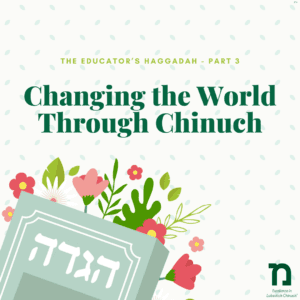By Chanah Rose
- Rachtza – Koreich: Taste, Touch, Crunch, Repeat
After the long stretch of telling, talking, reading, singing, delving and understanding, the next five Simanim of the Seder come as a crunchy, crumbly rush of Matza and Marror eating action. First we wash, then say the Bracha, then chomp down on our first brown and brittle piece of Matza as fast as we can, crumbs flying. Then comes the bitter juiciness of Maror, pale green in contrast, and finally, putting it together in Koreich with a sandwich piled higher than we can wrap our mouths around.
Yiddishket is a sensory religion. We don’t go to seek stillness on a mountain top, we roll up our sleeves to scrub our house for Pesach, knead the Matza with a specific recipe, down four cups of wine and grape juice, and so on – not just on Pesach, but throughout the year.
That’s why the best kind of Chinuch is experiential. We don’t just teach the children what to do, we do it with them. We sing, dance, create, touch, feel, and dive into the experience of Yiddishkeit. And not only in preschool.
For children of all ages, understanding is definitely important, but doing is what cements the lesson and makes it part of them. And on a deeper level, when the Rebbe introduced the 10 Mivtzoim, it was with the premise that the action of doing a Mitzva itself would awaken the Jewish soul, no prerequisite spiritual awareness needed. “Adam nif’al k’fi peulosav,” says the Sefer Hachinuch – “a person is formed (or in a play on words, acted upon) by his actions.”
Emuna itself comes from the root word “omein” – meaning a craft, or craftsman. Anyone who has done art or learned an instrument knows that the way you learn a craft is by doing it. We mold and form and strengthen our Emuna by practicing it, doing Mitzvos and experiencing living Yiddishkeit every day, in the classroom and out.
2. Shulchan Aruch – A Multi-Course Lesson Plan
And here comes the feast.
But it’s not just, “Let’s eat.” That’s not how we Yidden do things.
A Seudas Shabbos or Yom Tov, Shulchan Aruch no less, is a multicourse affair on a beautifully set table (until the toddler spills the grape juice bottle or someone falls asleep in their soup bowl, that is). In fact, that is the literal meaning of the term “Shulchan Aruch” – a “set table,” a carefully prepared meal that all can enjoy in the best possible way.
In the first Posuk of Parshas Mishpatim, Rashi comments on the words, “אשר תשים לפניהם – that you should place before them,” saying that Hashem is conveying to Moshe Rabbeinu:
“Let it not enter your mind to say: I will teach them each chapter or law two or three times until they are fluent in it exactly as was taught, but I will not exert myself to make them understand the reasoning or details behind each matter” – the verse therefore says: אֲשֶׁר תָּשִׂים לִפְנֵיהֶם “that you must (literally) place before them” – like a שלחן ערוך, a table laid before a person, ready for eating.”
This means that every lesson needs to be carefully planned, like a good Baalebusta’s Yom Tov menu, to have the desired outcomes.
“Don’t think,” says Rashi, “I’ll chazer the idea to them two or three times and then they’ll get it.” If you’re looking for spit-back, well, maybe that’s enough. But if you’re looking for true understanding, more preparation is needed, putting everything into place so that every child can eat, ingest and enjoy. Here are just a few examples, but every teacher can think of more:
- An appetizer as the “hook” to draw childrens’ attention and activate prior knowledge.
- Different courses to review the material through different modalities.
- The right utensils to allow students to fully access what they’re learning.
- Checking for understanding – which Shabbos or Yom Tov guests aren’t constantly pestered with questions of, “More? What else can I pass you?”
- Dessert for closure, reflection, and leaving everyone chewing over what they learned.
Although, ordinarily, dessert is optional… but not so in the Seder, or in Torah learning, as we’ll see in Tzafun.
3. Tzafun – Enrichment for All
Tzafun is when we eat the Afikomen, which is technically dessert. The word Tzafun, though, means hidden.
In our responses to the four sons, we tell the Chacham the laws of the Afkikomen, which can also represent the secrets of Tzafun, the hidden, inner dimension. We let him know of the wisdom still to come.
We started the Haggadah with a hook, or multiple ones, to pique the children’s interest. We ensured inclusion, invited questions, and reached all kinds of students. We laid out a lesson plan. We made the material clear. We engaged all the senses.
And now – for enrichment.
Enrichment is crucial for the upper third of every population of students. We often worry about the lower third who may be disenfranchised when they don’t feel successful in learning, but we need to also be concerned about the upper third, who may become disenfranchised when they don’t feel stimulated or intellectually engaged. (There is even a term, “gifted at risk,” to describe this phenomenon.)
However, enrichment is not only for the upper third, because every student needs to have a geshmak in their learning.The Rebbe taught educators that deep Chassidus is for everyone – it’s just up to us to make it accessible. Every student deserves to be inspired.
The approach of Chabad teaches us that inspiration without intellectual preparation is cheap and fleeting, but the extent of intellectual preparation can differ for everyone. The Rebbe ended every Rashi Sicha with the yayna shel Torah, the geshmak, after building the intellectual structure in a way that every Chassid can follow. If we build our lessons with scaffolding, if we climb the ladder of understanding from basic recall to higher order thinking, if we fill in the gaps and provide students with the skills they need,each at their own pace – then all of them can grasp the “aha” at the end.
All of them can feel the geshmak that comes from the depths of Torah, and the greater geshmak that comes from reaching the inspirational apex after “horeving,” toiling, and building the layers of understanding needed to get there.
All of them can reach Tzafun.
Never skip dessert.
Never skip the fire.
4. Bairach and Hallel – Words That Create
Next comes benching, and then Hallel. Thanking and praising.
What do we do when we thank and praise Hashem? Are these just words?
How about interpersonally, what happens when we thank and praise each other? Are we just being polite?
Chassidus teaches us differently. The word bracha also means a stream, or, to elicit [a stream of brachos]. When we bench, we don’t just thank, we elicit and effect an actual increase of bracha in this world. We open the tap for the brachos that are waiting to pour down on us.
Similarly with praise. The Posuk in Mishlei (27:1) says, “איש כפי מהללו”. A person’s stature is according to how he is praised. The Tzemach Tzedek teaches us in Derech Mitzvosecha that praising someone actually brings that quality out of them.
This dovetails with the Chassidic perspective on Shemiras Halashon. We are careful with what we say because our words actually create reality. Just like Hashem created the world through words, we have the ability to mimic this in some measure because our words bring latent potential into actuality. If we speak ill of someone, even if they don’t hear, this brings their negative qualities into the fore. If we speak well of someone, and point out their positive characteristics however hidden they might currently be, we strengthen these characteristics and amplify them.
As educators and parents, how do we speak to the children in our care, and how do we speak of them when they are not present? Which characteristics do we choose to amplify – in the principals’ office, at parent teacher conferences, in casual hallway interactions, and even in disciplinary conversations?
Do we highlight their inner greatness? When they falter, do we remind them who they really are and what they can be? Do we find every opportunity to point out their talents, their successes, their efforts – to “catch ‘em being good?” – and to praise them to others in a way that they can “overhear?” What is our inner dialogue like about these children – how do we think of them, even to ourselves? And then, which words do we choose to articulate in order to help them grow?
Perhaps this is one of the Chinuch lessons of Bairach and Hallel. Let’s use our words to bring out the best in all of us.
5. Nirtzah – Future Forward
We end the Haggadah with the future – may it be right now.
In fact, the Alter Rebbe’s nusach indicates that there is no end to the Haggadah (omitting the words found in other Haggadahs, “חסל סידור פסח – the Pesach Seder has ended”). We are always moving forward, taking these lessons with us.
One of the main features of a Chassidishe Chinuch is its emphasis on future – on Geula – and on purpose.
In fact, the word future is the wrong word because in the Rebbe’s teachings, Geulah is right now, latent in every single moment, every deed, and every way we choose to look at the world.
And this power is in the hands of every child.
An educational study by Rabbi Dr. Aryeh Solomon found that one of the three foremost themes in the Rebbe’s teachings is the redemptive quality within Chinuch. In the Rebbe’s worldview, no child is unteachable, no moment unredeemable, and no situation unsolvable.
We have an unflagging positive emphasis in our Chinuch, and are always looking ahead to the unfolding purpose that we all have a part of.
When I transferred from Bais Yaakov to Bais Rivkah, this is what I found as the main difference. Yiddishkeit was not stagnant in a Chassidishe Chinuch. It was not a checklist of “good girl” behaviors to check off and then you were done. Yiddishkeit was vibrant. You were never finished. There was always more to accomplish – whether reaching inward, to deeper and more emesdike avoda, or whether reaching outward, to transform every corner of the world.
And children – children matter in this scheme.
Children are not “practice Yidden.” Through Tzivos Hashem, the Rebbe showed children their power, and their power is now. Through their efforts, their battles with the Yetzer Hara, and their unique Avoda – the children are changing the world.
Not tomorrow, not after Bar or Bas Mitzva, but today.
So here we are, at the end of the Seder, Mechanchim and Mechanchos each in our own way.
Let’s remember that every interaction we have with our students and children matters.
Let’s remember that everything they accomplish in their own way has transformative power.
Let’s remember that these kids are changing the world.
And we are the lucky ones entrusted to inspire them, through Kadeish, Urchatz, Karpas… and all of the lessons of the Pesach Seder, that last for the entire year.





